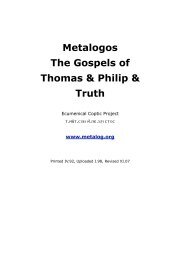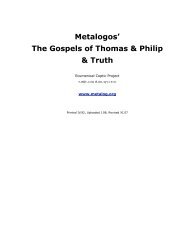Andrew Louth - Syriac Christian Church
Andrew Louth - Syriac Christian Church
Andrew Louth - Syriac Christian Church
You also want an ePaper? Increase the reach of your titles
YUMPU automatically turns print PDFs into web optimized ePapers that Google loves.
200 NOTES<br />
(1962). For Maximus’ attempt to correct Evagrian metaphysics, see<br />
below, chapter 5 of the Introduction.<br />
5 See Jerome, Ep. 133.3 (ed. J.Labourt, VIII, [Paris, 1963], 53).<br />
6 To use the usual English equivalents, which are not always quite<br />
appropriate: the Greek terms are gastrimargia, porneia, philarguria,<br />
lypê, orgê, akêdia, kenodoxia, hyperêphania.<br />
7 Evagrius, Logos Praktikos 81 (Guillaumont et al. [1971], 670).<br />
8 Idem, ibid. 64 (Guillaumont et al. [1971], 648).<br />
9 Evagrius, On Prayer 53 (cf. Palmer [1979], 62).<br />
10 See Garrigues (1976), esp. 176–99; and Heinzer (1980), 181–98.<br />
11 On the vexed question of Greek and Latin words for love, Oliver<br />
O’Donovan’s comment is pertinent: ‘It may be convenient for modern<br />
thinkers to label certain motifs by the Latin or Greek words which they<br />
think incapsulate them, but they should not then suppose they have<br />
discovered a lexicographical statute to which ancient writers can be held’<br />
(O’Donovan [1980], 10–11). On the language of love in Plato and the<br />
Fathers, see most recently Osborne (1994).<br />
12 CC II.8, and cf. his doctrine in Ep. 2 (397BCD).<br />
13 Cf. also CC I.55, II.14, III.56, IV.21.60f.<br />
14 Cf. Ep. 2:405A.<br />
15 See, for instance, CC II.16 (definition of passion) and II.17 (definition of<br />
vice).<br />
16 Diadochus of Photikê, Century on Spiritual Knowledge 17, cf. 72 (des<br />
Places [1966], 94, 131).<br />
17 For ‘sabbath’, cf. Isa. 66:23; for ‘sabbaths’, cf. Exod. 31:13; for ‘sabbaths<br />
of sabbaths’, cf. Lev. 16:31 (LXX).<br />
18 For a more detailed analysis of the bulk of this Difficulty, see chapter 5<br />
of the Introduction, below.<br />
19 Makarios, Hom. 15.38 (ed. H.Dörries, E.Klostermann and M.Kroeger,<br />
Patristische Texte und Studien, 4, Berlin, 1964, pp. 149f.).<br />
4<br />
THE DOCTRINE OF THE PERSON OF CHRIST<br />
1 See Opusc. 20: PG 91:237CD, 244C–245A; 28:328C–329B.<br />
2 Translation from Tanner (1990), 86–7 (slightly modified).<br />
3 For an account of the historical development of the logos/tropos<br />
distinction and its use by Maximus, see Sherwood (1955a), 155–66; and<br />
Heinzer (1980), 29–58.<br />
4 Gregory Nazianzen, Sermon 39.13 [PG 36:348D]. Gregory’s sermon is<br />
for the Feast of Lights, i.e., the Theophany (or the Epiphany).<br />
5 See Andia (forthcoming). Amb. 10.31B-H makes this identification<br />
virtually explicit.<br />
6 See Lethel (1979), esp. 31–5.<br />
7 On this, see Heinzer (1980), 59–116.<br />
8 Athanasius, On the Incarnation 43.<br />
9 Gregory Nazianzen, Letter 101.32.




